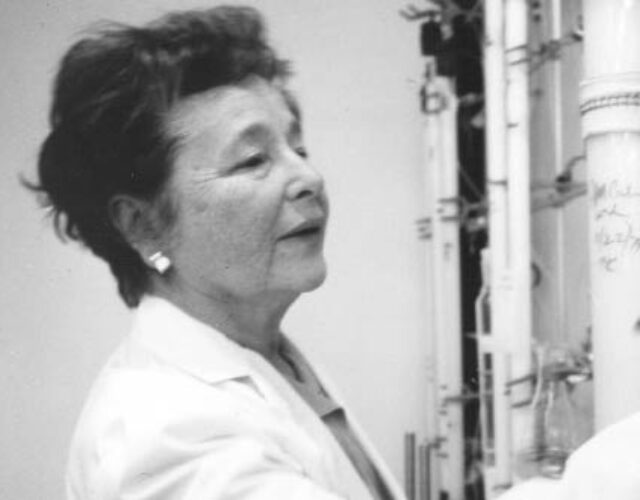Gertrude Belle Elion (1918–1999) was a teenager when her grandfather died of stomach cancer in 1933. From that point on she wanted to be a scientist so that she could fight disease. In 1937, just after she completed her chemistry studies at Hunter College in New York, Elion lost her fiancé to a bacterial infection, and her passion for finding cures for illness was redoubled.
Elion entered New York University’s graduate chemistry program in 1939. She was the only woman in her class, but times were changing. By the time she received her master’s degree in 1941 the United States was fully embroiled in World War II and opportunities in the sciences were newly available to women. After trying a few jobs Elion began work as a biochemist in 1944 at Burroughs Wellcome (now part of GlaxoSmithKline), planning only to stay until she stopped learning new things. But she found her new job was an ideal place to carry out her search for cures for disease, and she ultimately stayed at the company for more than three decades.
In the mid-1940s the discovery of most new drugs was achieved through testing the effects of various known compounds. But George Hitchings, Elion’s supervisor at Burroughs Wellcome, believed that in the search for drugs to treat cancer and bacterial infection it made more sense to start by studying the biochemistry of cancer cells and bacteria. Armed with an understanding of how these cells grow, Hitchings and Elion could design and build molecules from the ground up. If they could design a molecule that would interfere with the reproductive mechanism of the cells, they could stop the growth of tumors and infection.
Although the structure and genetic function of DNA were not yet known in the mid-1940s, researchers did understand that DNA is necessary for cellular reproduction and is composed of two classes of nitrogen-containing bases: pyrimidines (cytosine and thymine) and purines (adenine and guanine). Hitchings and Elion began investigating the purines and soon discovered that cells could not produce DNA without them.
This discovery led them to pose some important questions: if they could prevent cancer cells from incorporating adenine and guanine into their DNA molecules, could they stop cancer cells from dividing and therefore stop tumors from growing? Could cancer cells be tricked into incorporating structural analogs (other purines that were shaped like adenine and guanine) into their DNA, and if so, would this prevent the cells from reproducing? To answer this question they would have to make structural analogs that would only affect cancer cells, while leaving the DNA of healthy cells alone.
By 1950 Elion had developed diaminopurine and thioguanine, purines that could treat leukemia by stopping its cancerous white blood cells from reproducing. The purines worked just as the two scientists had hypothesized. These drugs had some undesirable side effects, but Elion didn’t give up. A new drug she discovered, 6-mercaptopurine (6-MP, trade named Purinethol) was even more effective, though still not effective enough, at treating leukemia. After more research, doctors found that 6-MP worked best when used with other drugs. This treatment is known today as combination therapy, and children who get leukemia are now usually treated successfully with 6-MP combination therapy.
Elion’s discovery of 6-MP led to another important treatment. An adverse effect of the drug was that it weakened the immune system; a British doctor named Roy Calne thought this effect might be advantageous in some cases. He investigated whether 6-MP could be used to shut down a patient’s immune system at times when it needed to be “turned off”—for instance, during organ transplantation. The immune system usually rejects a transplanted heart or kidney, putting the patient’s life in grave danger. Because of this risk few organ transplants were carried out before the early 1960s. Although 6-MP worked well, Calne found that another of Elion’s compounds worked even better. Imuran, with the generic name azathioprine, was first used to suppress the immune system in human kidney transplants in 1962, and kidney and other organ transplants have become common since then.
A few years later Elion and Hitchings asked the next question: if drugs like 6-MP could stop cancer cells from reproducing, could they also stop bacteria from reproducing? If so, drugs like this could be used to fight bacterial infections. To answer this question, Elion and Hitchings invented new drugs that were similar to 6-MP and Imuran, including pyrimethamine (trade named Daraprim) used to treat malaria, and trimethoprim (a component of Septra and Bactrim) for treating meningitis, septicemia, and bacterial urinary and respiratory tract infections.
In 1967 Elion became the head of Burroughs Wellcome’s department of experimental therapy and continued her quest to fight disease. Along with Sir James W. Black, Elion and Hitchings received the 1988 Nobel Prize in Physiology or Medicine for their discovery of important principles for drug treatment. Although she never received a doctoral degree, Elion reached the pinnacle of success in the field of biochemistry at a time when women had to struggle for recognition in the sciences. Her work revolutionized the very method by which drugs are developed to this day.




